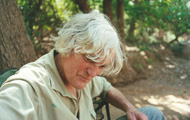- Swimming
- Interview :: Mick Munroe
- Interview :: Andrew Jennings
- Boating
- Interview :: Bob and Carol Lewis
- Interview :: John Southwood
- Object :: Kayaks
- Object :: John Southwood's Kayak
- Object :: Olympics Blazers
- Fishing
- Interview :: Kevin Laughton
- Object :: Brown Trout
- Object :: Fly Lines
- Object :: Fishing Rods
- Object :: Golden Perch
- Object :: OTAS Memorabilia
- Parks, Gardens and Fountains
- Interview :: John Chappell
- Object :: Water Stress Sculpture

John Chappell
John Chappell has been studying the behaviour of natural systems such as deserts, rivers, coasts, coral reefs and climate for the past 40 years in Australia, New Guinea, China and other regions, since joining the Australian National University as a graduate student in 1965.
'When standing outdoors, the weather influences both droughts and wet spells in "Water Stress", symbolising the natural unpredictability of our water resources.'
Water is connected throughout the earth: rivers, groundwater, irrigation, oceans, rain, and evaporation. The price of over-use in one region may be degradation in another. "Water Stress" is a visual expression of water cycling and water use, from initially sustainable flows, to depletion and catastrophic zero.
The Water Stress machine is structured on a central sloping plane that divides tablelands from an irrigated valley: mountain stream feeds both landscapes. As time passes, an increasing amount is diverted to irrigation. The water table then rises beneath the valley, while groundwater beneath the tableland dries up. Drought sets in and mountain streams become mere trickles. Only after persistent drought does circulation return to normal, until the next cycle of water greed sets in.
This maladjusted behaviour of the machine can be avoided if the allocation to irrigation is reduced: drought cycles then cease and “Water Stress" will run uneventfully, sharing water between the natural and irrigated regions.